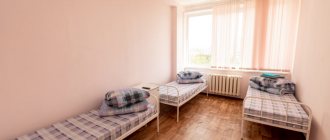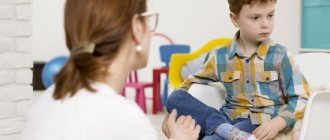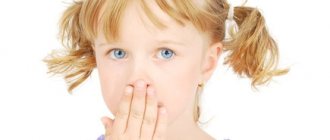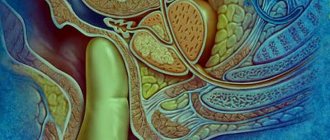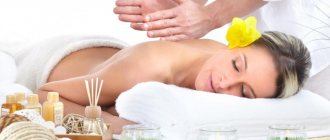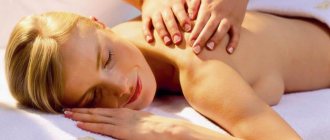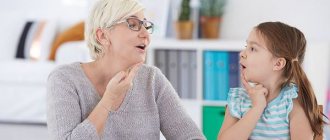general information
The main purpose of massage for stuttering is a mechanical effect on the condition of muscles, nerves, and blood vessels. Conducted by a speech therapist, probes are used if necessary.
Logomassage is part of complex therapy. In other words, it cannot be a panacea, but it can improve the child’s condition.
Children begin to stutter for various reasons. Scientists believe that it’s all about a combination of genetic and neurological factors. A predisposing factor is muscle hypertonicity. In adults, the disease appears after concussion, head injury, or stroke.
Massage can be used both in a special institution and at home. But before using it, doctors check the patient. The procedure has contraindications. The exposure is carried out in courses with a short break between them.
Massage helps to relax the muscles - vocal, articulatory, regulating the breathing process. The child’s mental state normalizes. Metabolism increases and blood circulation improves. Against this background, there is a decrease in the manifestations of stuttering.
Efficiency
Acupressure massage for stuttering in adults and children is prescribed after examining the general somatic health, central nervous system, mental and psychological state of the patient. If there are no contraindications, the patient undergoes 1 or 2-3 courses of procedures.
The effectiveness of acupressure for stuttering in children is as follows:
- The muscles that regulate breathing, articulation, and vocal cords relax.
- The child's immunity is strengthened.
- The patient’s mental and emotional state is normalized.
- Improves blood circulation.
- Metabolism increases.
- Stuttering is minimized or eliminated completely.
Types of massage
The classification and sets of exercises were developed by Dyakova. She identified the following types of massage:
- point;
- probe;
- segmental.
Each requires the use of certain techniques. They affect the area of the neck, shoulders, and head. The specialist must have a good understanding of human anatomy and physiology and know the location of the cranial nerves.
For stuttering, acupressure and segmental massage are most often used. Sometimes a combination of them is effective.
For probe massage, special instruments are used - probes. They allow you to relieve hypertension or activate muscles.
The method of influence should not be perceived as a panacea. This is only additional help in case of a defect, but if you use only it alone, there will be no result.
Technique
Acupressure for stuttering does not have to be done in a clinic or hired by a specialist. You can undergo treatment at home. This does not require special skills or knowledge. It is enough to have an idea about acupuncture, to be attentive to the child’s condition while kneading points on the body and to obtain permission for independent therapy from a pediatrician or neurologist. A ban on self-medication is imposed if children have a history of numerous concomitant pathologies, muscle tension is very strong and it is impossible to cope with it without the help of a specialist.
Before you begin massage therapy at home, find the right points on your child's body. Study the educational pictures and diagrams of their location, try to feel them in an adult and a small patient. Gently press on the points. If the child feels a slight ache or a slight aching pain when touched, then the point has been found correctly. Remember where it is located, you can make marks with iodine or brilliant green. After searching for all the points, you can begin treatment at home.
Indications and contraindications
Speech therapy massage for stuttering is prescribed for any problems with muscle tone. During convulsions, they may become excessively compressed, tense, and it will be difficult for the child to return them to normal.
Relaxation plays an important role in the correction of stuttering. It is not easy to teach a patient to relax. Massage has this effect. If it is manual, it brings additional pleasant sensations.
Before the course, the speech therapist conducts diagnostics. He looks at the condition of articulatory and facial muscles. Checks the condition of the neck and shoulders. Draws attention to:
- asymmetry;
- skin rashes;
- skin color;
- hemorrhages.
After which palpation is carried out, that is, palpation. The speech therapist touches areas of the body with his fingers - this allows you to better feel the condition of the muscles. A similar examination is carried out in adults.
An absolute contraindication is epilepsy. Additional exposure may trigger seizures. Temporary relief is somatic diseases, injuries, inflammations.
Modern methods, tools and techniques for speech therapy massage
Speech therapy massage for stuttering can be both the main treatment method and an auxiliary one.
Logomassage classification:
- traditional (during the manipulation, the specialist strokes, rubs and kneads the patient’s legs and arms);
- point (speech therapist acts on biologically active points);
- probe (carried out using instruments - probes);
- segmental-reflex massage (classical techniques and methods are used, the doctor massages certain segments and zones).
Logomassage is prohibited for herpes, gingivitis, stomatitis, enlarged lymph nodes, skin rashes, inflammation, conjunctivitis, somatic and infectious diseases
Requirements for conducting
Before starting to relax the patient, the specialist must prepare the room. The office is washed, ventilated, and made cozy. The child should not create associations with the medical institution, as this will cause a negative reaction.
On average, procedures are carried out every other day. The usual course duration is 20 procedures. After which they take a break for a month, and the cycle is repeated again.
In childhood, they begin with short sessions of five minutes, gradually increasing the duration to half an hour. In adults, the same scheme is used. The child should not experience pain. Some effects may be unpleasant, but not cause acute discomfort.
It is advisable for the speech therapist to wear a sterile mask. The specialist’s hands should be clean, warm, with short-cut nails. Before starting, lightly lubricate the skin with oil or powder.
The optimal position is for a stuttering child to lie with his back on a flat couch. This position is convenient for the speech therapist and frees breathing. In some cases, a half-sitting position in a chair is allowed, with the child’s head thrown back on the headrest.
Sometimes it is convenient for a specialist to stand not behind the patient’s head, but on the right side of him. In this position it is easier for him to secure the child.
Causes of stuttering:
- increased tone and periodically occurring convulsive readiness of the motor endings of the speech centers of the brain;
- consequences of acute and chronic stress in childhood;
- genetic predisposition (some types of stuttering are inherited);
- consequences of perinatal damage to the central nervous system;
- tendency to have a convulsive reaction;
- various brain injuries;
- injuries, consequences of infectious and endocrine diseases;
- disruption of normal speech development in children (early speech development and delayed psychomotor development);
- children can imitate a person who stutters, but after a while they will develop a stable defect;
- when trying to retrain left-handedness in childhood;
- lack of affection, love, and understanding in a child.
At the age of three, young children develop the coordination system of speech movements and verbal thinking. Speech at this age is the most vulnerable and vulnerable area. Impaired speech development is due to the fact that young children are very easily overstimulated, some of them have a tendency to convulsiveness. A feature of the neurophysiology of this age is the fact that they do not have strong inhibitory reactions. The risk of developing stuttering in an excitable child is much higher than in a phlegmatic child.
Stuttering in children can occur as a result of strict upbringing and increased demands on the child. Some parents want to raise their children to be geniuses; they force their children to memorize large poems, pronounce and memorize difficult words and syllables, which in turn can cause speech development disorders in the child. Stuttering in children can increase or decrease. Provoking factors for increased stuttering can be overwork, colds, disruption of the daily routine, and punishment. If a small child has the first symptoms of a speech disorder, you should immediately contact a specialist; it will not go away on its own.
Stuttering in children must be cured before school. In order to understand how to get rid of stuttering, parents with children aged 2-5 years turn to a speech therapist.
Speech disorders observed during puberty are one of the manifestations of neurosis. Speech impairments may improve as a person gets older. According to statistics, only one percent of the adult population suffers from stuttering.
Basic Techniques
Each session begins with stroking. It is alternated with other techniques, but it is always completed with this technique. It can be superficial - the brush lightly touches the skin, gently and affectionately, with a deep grasping movement it affects the skin receptors and the nervous system. The palm is pressed firmly against the area and glides along the anatomical contours.
Stroking the “rake” - the fingers are spread wide, the pads actively massage the area of pressure. Performed in a circle, zigzag, wavy.
Rubbing involves applying strong pressure to a small area of muscle. It is performed both with the fingertips and the entire palm. The degree of impact is determined individually. Directions are spiral and straight.
Kneading - the fabric is gently rubbed, squeezed, compressed. Used in a small area. Perform with fingertips; in rare cases, pinching is allowed.
Vibration is created by lightly tapping your fingers on the surface of the muscles. Used in areas with minimal fat and where cranial nerves exit. Firm pressure allows you to target biologically active points (BAP).
The help from speech therapy massage will only be felt if the sessions are regular and the specialist is highly qualified. The choice of techniques depends on muscle tone and pathological features.
Segmental massage
Relaxing massage of the orbicularis oculi and lip muscles
Its goal is to target one specific area of muscle. Requirements for conducting are standard. The speech therapist's hands should not have abrasions, scratches, or wounds. All rings, bracelets, watches are removed. Fingers are lubricated with baby cream. Areas of influence are determined after diagnosis.
Before starting the session, it is useful to take a moment of relaxation. The patient is encouraged to relax and is asked to imagine being in a comfortable place. Once he has calmed down and is breathing evenly, you can begin to act.
The optimal position is lying on your back. All types of stroking are used, starting with a gentle effect. Palms gently touch the face, neck, shoulders. They move gently from bottom to top. Gradually the impact becomes stronger, the pressure increases slightly.
Rubbing is intended to stimulate blood circulation. Therefore, the speech therapist identifies problem areas (pale skin) and begins to actively rub them. It is better to do this in circular movements, as they are more comfortable.
The degree of vibration depends on the condition of the muscles. With hypotonicity, it should be strong, sensitive, palpable. With hypertonicity, on the contrary, it is barely noticeable.
The effect of logomassage will only be achieved if a set of techniques is implemented. Separately they are useless.
Finish with gentle stroking. Then the patient is allowed to lie down for a few minutes.
Speech therapy massage
Special types of massage - speech therapy - are aimed at eliminating speech disorders. Speech therapy massage for stuttering is divided into two types:
- Spot.
- Segmental.
They are used individually or in combination. A massage that will save you from stuttering is performed in the following areas:
- Upper back.
- Head.
- Neck, collar area.
- Upper shoulder girdle.
- Upper chest.
- Facial muscles.
When carrying out manipulations it is important:
- have information on the features of the mechanisms that caused the development of the disorder;
- represent the structure of facial and other muscles;
- know the locations of the main nerves.
Acupressure
The difficulty of carrying it out is that it is necessary to correctly determine the localization of BAP (active points). With increased tone, a relaxing effect is used. It is aimed at reducing tension. The location of the BAP is best studied using an illustration or under the supervision of experienced specialists.
Massage of biologically active points
It’s simple: the finger rotates clockwise over the pressed area for 6 seconds. Gradually it seems to deepen, increase the force, then it is fixed for 2 seconds and the action is weakened in 5 seconds.
The pressure decreases counterclockwise. Without lifting your finger, this cycle is repeated 3-4 times. It takes about 1 minute to complete one point.
When tone is reduced, another technique is used - stimulating. The finger presses on the point clockwise for 6 seconds, and then the pad suddenly comes off. The movement is repeated up to 10 times.
In the first session, a maximum of 4 points are affected. Gradually the quantity is increased. In one procedure, general and local points are affected. Symmetrical points are massaged simultaneously.
It is advisable to combine acupressure massage with classical massage. It is better to conduct it before a session with a speech therapist. This way the child will be relaxed and the exercises will be easier for him.
Self-massage
A specialist can teach children self-massage skills. This doesn't require much effort. Preschoolers are taught in front of a mirror, shown an example of an action and asked to repeat:
- The first exercise is to gently stroke your cheeks with your palms, working from your nose to your ears. You can stroke the head, going lower from the hair.
- The second exercise is to run your fingers with pressure from the middle of the forehead to the temples, as if drawing paths. You can draw a “Christmas tree”.
- The third exercise is tapping the forehead and cheeks with pads. There may be more exercises. The complex is compiled by a speech therapist based on the individual characteristics of the child.
Krupenchuk has her own method. She improved the Dyakova complex. Regular spoons are used for massage - this is perceived more positively by the child.
The process can be combined with games. In this case, it will be more interesting for children to complete the tasks of the speech therapist. As an incentive, you can give a sticker or the opportunity to choose a game.
